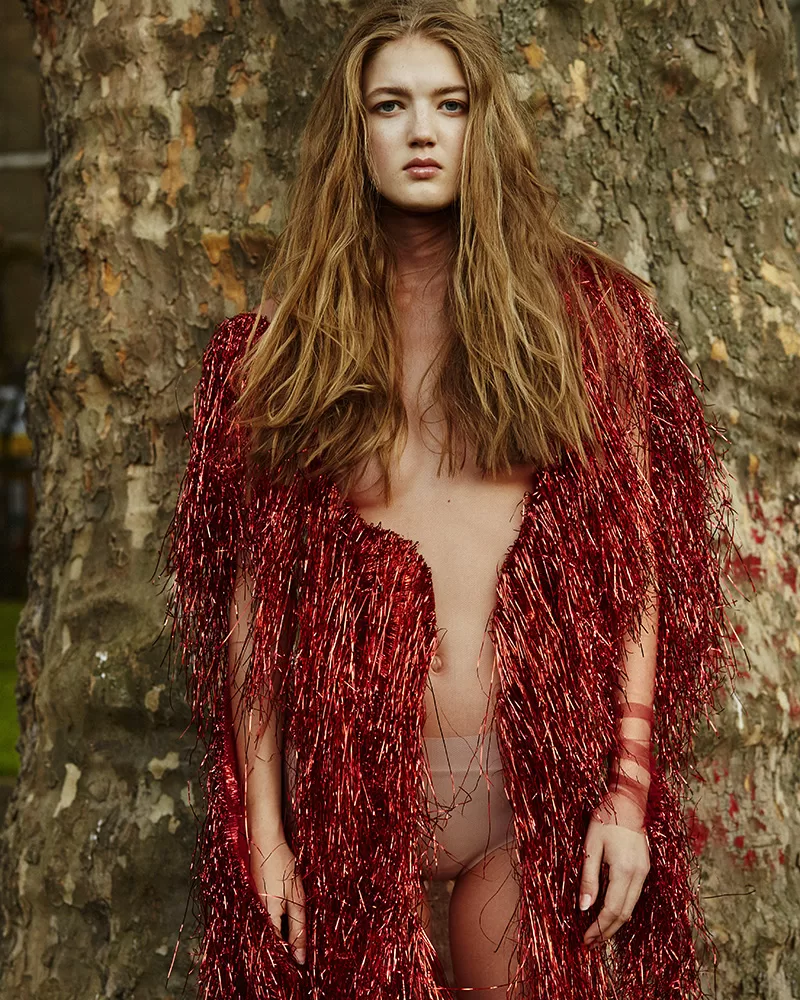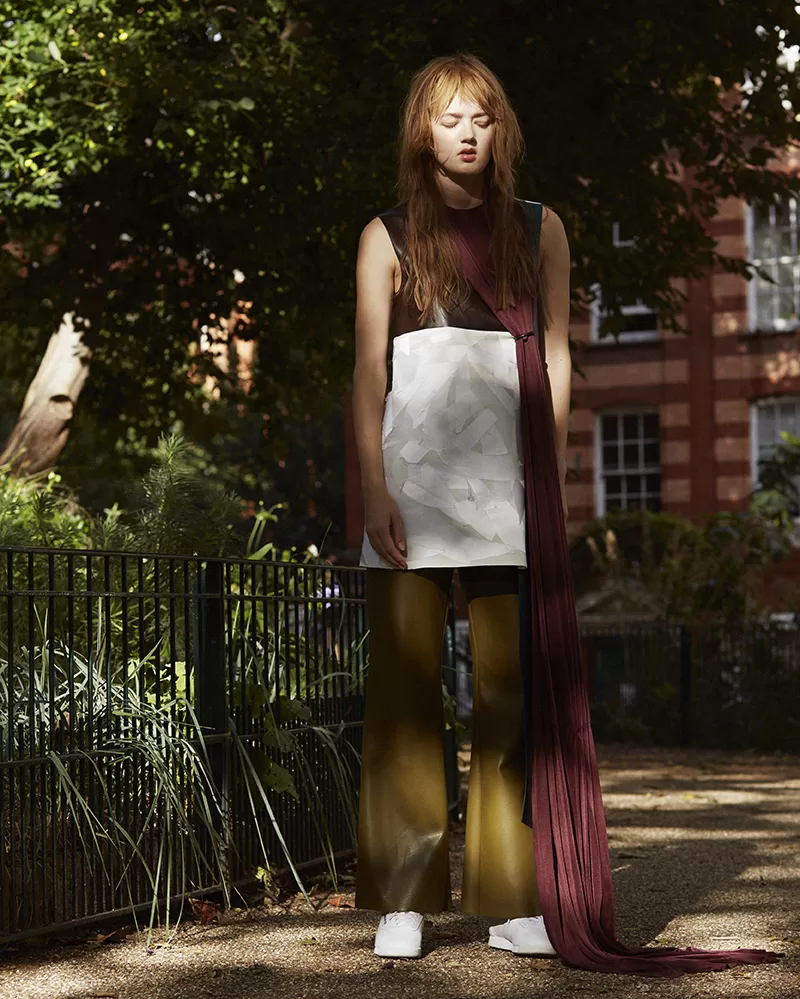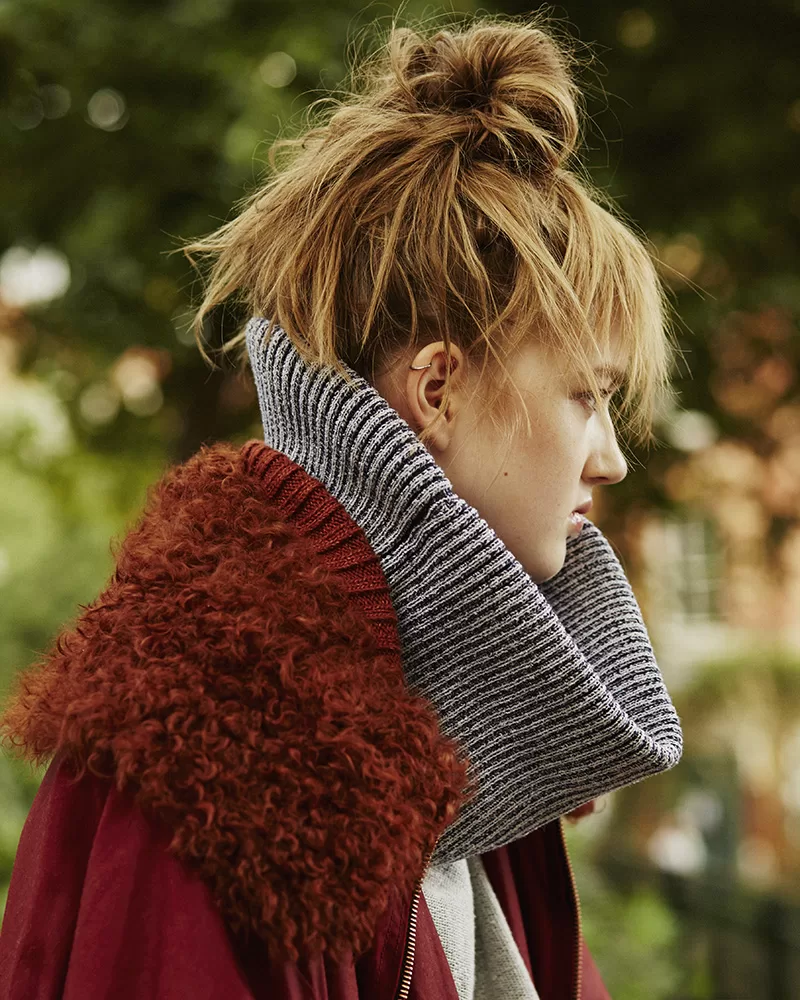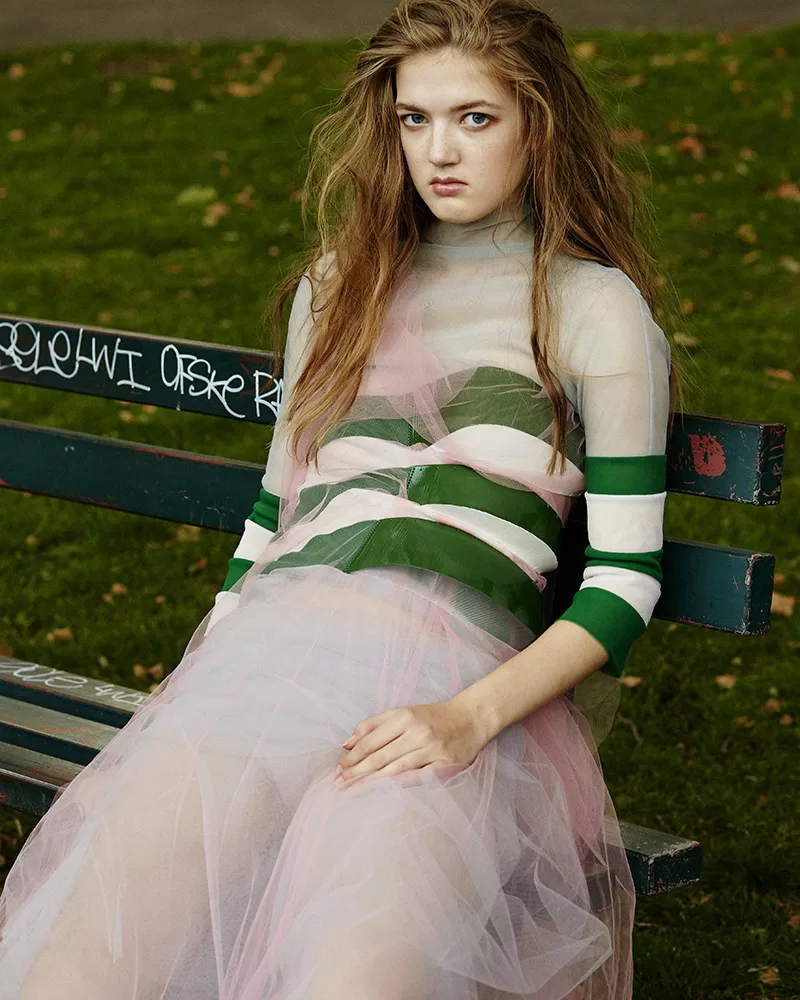Graduates – Womenswear

Paula Knorr
Having recently graduated from the Royal College of Art, German designer Paula Knorr has already distinguished herself amongst the industries strongest young talent. Since showcasing her Bachelor collection at Mercedes Benz Fashion Week in Berlin, Paula has gone on to win the acclaimed Fashion Award at this years International Talent Support competition for her sensuous MA collection entitled Her Wet Skin. Here, we talk to the gifted designer about creative synergy, her infatuation with the female form and what we can expect to see from here on in.
What inspired your latest collection and why did you decide on the title Her Wet Skin?
The collection is inspired by the answers of twenty-five different women that I interviewed about their thoughts, wishes and anxieties around womanhood. To translate the answers to the viewer, I recreated these true feminine heartstrings into twenty-five different videos, which play with the interaction between artificial materials and nude body. The title Her Wet Skin is inspired by these videos. I wanted to choose a title that awakes memories and lets you re-feel the sensuality of the videos.
My garments as well re-feel the interaction and motion captured in the videos, fulfilling the thoughts of these women by creating a new poetic womenswear identity; loose metallic straps are sliding down matt nude dresses. Frozen in motion, they create a contrast between artificial lightness and sensual nude skin. Glossy fabric pieces are moulded around the woman’s shape, creating a relief of the body, fixed in place by a lycra backside. Always focusing on the contrast of movement and time; pure beauty and dissolving rawness.
You incorporated video into your methodologies, which focus on the synergy between artificial materials and the nude body; what is it about this interaction that you find so fascinating?
I wanted to choose a medium that visualizes the often contrasting and hard to define emotions with easily recognizable materials. By creating motions that are reminiscent of little everyday moments, everybody is able to directly feel what happens in the video. The ‘sliding down wet skin’, ‘foil peeling of the skin’, ‘wet paper sticking and bursting’. These little moments, multiplied and closely observed, create intense passionate and sensual feelings to the viewer.
You say that this collection was constructed with the thoughts, wishes and anxieties of the women that you interviewed in mind. What is it about the female psyche that interests you?
The whole collection accrued out of the protest against habit that particularly in education in fashion design; the main reason why we are creating gets totally lost. That garments don’t have to have a relation to the woman that wears them anymore; some students work are more sculptures than actually relate to the woman’s body underneath.
I wanted to do the exact opposite and work closely together with real female personalities and incorporate their thoughts and feelings into every stage of my design process. From the women I interviewed at the beginning to the models that worked together with me in many draping sessions; everyone influenced the design process. To collect emotions and thoughts at the beginning was important to study to see how different female bodies and personalities wear and move in my designs.
The goal was to create a collection that is unbiased and strongly permeated from the personalities of the wearer. The fact that I chose to base it on the female wearer is not exactly important. The main importance for me was to remind people of the purpose of fashion, that a person actually wears a garment and creates a relation with it.
Her Wet Skin is a collection with the female form at its core, do you feel as though your work is concerned primarily with gender or is it more of an exploration of personal identity?
Certainly more about exploration of personal identity. I wanted to involve many different female personalities to create a vivid and direct variation of womenswear. To go away from the gender prejudices picture of womenswear and create a fresh idea that centres on the recreation and perception of different personalities is the main point.
Perceptions of gender are rapidly becoming blurred within the progressive world of fashion; what are your thoughts on this and does this factor into your design process?
My main intention in my design work is to listen and explore the person I create my design for. While creating ‘Her Wet Skin’, I often put myself in the position of an explorer of the female psyche and creation instead of predetermining everything too much with my own single opinion. I think it’s great that with the blurring of gender in fashion the design process gets much more personally inspired because the designer can’t revert to precast gender ideas.
Can you tell us about your plans now that you have graduated?
I work freelance at the moment for different companies but also create ideas for stylists under my own name. I continue to apply for some more fashion awards after winning the fashion prize from International Talent Support (ITS) this year that requires me to create a new collection for next year. I think we graduates should use our year after graduation to see how far we can get with our ideas but in the future I would certainly like to work for a bigger fashion house; I really enjoy working in a team.

Sara Terp Hansen
Central Saint Martins graduate Sara Terp Hansen’s powerful approach to sustainable fashion has penetrated the industry with harmonious innovation. Since winning the Balance Award at Fashioning the Future in 2011, the vicarious designer continues to instil an overwhelming emphasis on the importance of viable, primitive design. Here, Sara communicates her thoughts on femininity, new possibilities and the comings and goings of fashion.
Can you tell us the title of your latest collection and why you chose this?
The Collection is named Farah Rei. She’s a character I built my collection around; a different, more fantastical version of myself.
What were your main sources of inspiration?
The balance between strength and power vs harmony and peace rooting in the movements of T’ai Chi, touching upon a world of colour sensitivity.
The collection educes a sense of primitivity and ease, why did you decide to communicate this into your designs?
I’m easy and primitive; clothes shouldn’t constraint.
As a female designer creating womenswear, how do you approach the female form in design?
I appreciate femininity, but at the same time I think femininity needs an antidote in some form, in order to be relevant today.
During the design process, do you consider the recent progression in gender fluidity and with this in mind, do you think gendered fashion is an out-dated concept?
No, not necessarily. The different body shapes of sexes make fashion and garment construction interesting. Gender fluidity might seem connected to the time we are living in now, i.e. women are searching for a masculine expression in order to gain power and men are trying to get in touch with their femininity, so they can keep up with women. Fashion comes and goes and changes according to relevance.
You successfully won the Balance Award at the Fashioning the Future Awards in 2011. What impact did this have on your approach to design?
I realised there’s a need for new initiating voices to be heard and there are people who want to listen. Fashion is standing still today – just replication and copying. It’s like it needs a new territory to tap into in order to get truly creative again. I believe this world of (“sustainable”) fashion has big potential. The design should always come first but the procedures of producing can be revitalised.
Why is the sustainability of fashion important to you?
I represents new possibilities. Fashion is a huge business industry and I question how creative it is. Obviously there are different layers but as soon as money gets involved it very often loses vital energy. I’m not quite sure what sustainable means anyway, it’s a label that can easily mislead. For me, it means you have considered ethical aspects in your practice but then, what’s ethical to me, might not be for you. It’s all subjective; to put a name on it is tricky. I do believe though, that if the current fashion world wants to survive and present themselves as contemporary innovators, they will have to wake up.
Do you find that this can conflict with the commercial viability of a collection?
No it’s the opposite for me it only ads desirability to a collection if these aspects are thought through.
What are your plans now that you have graduated?
Keep exploring, learning and expressing.

Hannah Jinkins
Having recently graduated from the Royal College of Art, Hannah Jinkins has captured the attention of some of the industries leading brands including premium Japanese denim mill, Kaihara, who sponsored her latest collection. With an emphasis on the unanimity of gender and a desire to improve sustainability Hannah has been highlighted as one of the upcoming designers to watch. Following this, we talk to Hannah about the definition of femininity and find out exactly what it takes to keep her sane.
What were the main inspirations behind the collection?
AW15 combines explorations of gender, mending techniques and denim culture.
I’m fascinated by used, damaged or broken things and my collection seeks to reveal the beauty of worn out objects/clothes. When researching denim and the culture surrounding it, I began looking at Japanese processes/mantras such as Wabi-Sabi and Boro which led me to explore Kinstugi.
The whole collection was really explorative, and really self-indulgent. The silhouettes were formed through a really organic process —I developed a custom-made, tailoring method of ‘staple-to-fit’, which I use to shape, fit and feminise oversized, masculine garments.
Using both raw and coated denim (wet-look coatings such as gloss, wax and latex were inspired by workwear, fishermen etc) , I took masculine shapes and rough materials and feminised them through manipulating, fitting and shaping to create garments that play with ideas of spontaneity and happy accidents.
You were heavily influenced by a range of diverse processes such as Japanese Boro and Kintsugi, what attracted you to these particular methodologies?
I love deconstructing garments to reveal details, I think there’s a real beauty in the things that get hidden and polished — I much prefer the unpolished, where you can see the craftsmanship that has gone into things.
There’s a really interesting book on Wabi-Sabi by Leonard Koren, which I read after seeing the Boro show at Somerset House. It all tied in really interestingly whilst I was doing my dissertation on denim culture and there was just something natural about building all these elements together.
Why did you decide to work with denim?
Having looked at gender and identity, denim just felt right. My dissertation was also a study into the reasons behind the popularity of jeans and denim culture. Something I found extremely interesting is that, even now, denim can still have very masculine connotations, so I wanted to explore that. I wanted to play with raw, heavy denim and find my way of feminising it without taking away the properties I love about it.
Equally, the entire collection was about creating unique garments through the tailoring process and using denim added another layer to this. The wearing properties of raw denim and how the cloth takes on the identity of the person wearing it was something I wanted to build from. The way I shape and coat the garments encourages them to wear in certain ways and they will wear specifically for the individual.
The art of re-use and reclamation is prevalent throughout; what is it about this concept that you find so fascinating?
The fashion industry is incredibly wasteful, so in the development stages, I worked a lot with existing garments, recycling and reworking pieces and exploring the ‘staple-to-fit’ technique. Fashion constantly builds upon everything that has gone before and I think re-appropriating details is something that I worked with a lot.
The collection challenges traditional forms of gender and what it means to be a woman, What are your views on gender fluidity and how does impact your design process?
I think there is a huge focus on gender fluidity in the media at the moment and it concerns me it could be pulled into being a trend or fad. Challenging traditional gender norms is not new, but I think it quite often lands on menswear to make these moves as it is deemed more ‘shocking’.
My collection was really about finding a kind of harmony between the masculine and feminine and what that meant to me. Being feminine isn’t about being pretty and delicate to me, it’s about combing strength, comfort and luxury and I hope the collection reflects that. The silhouettes were fitted to ‘real’ women, and though the garments have quite a tough shell, I focused a lot on comfort and integrating ergonomic details.
With this in mind, do you think that the notion of gendered fashion could be considered obsolete?
Yes. And no. The fashion industry may be fully embracing gender fluidity and I think it’s a really promising time for equality. However, I worry the media frenzy surrounding it can mask the importance of bigger issues surrounding gender.
It’s exciting that the lines are blurring. Men and women’s fashions will keep evolving and influencing each other; it is inevitable.
I think genderless fashion will become a ‘sector’ (for want of a better word) within the industry but there will always remain that divide because ultimately, that is what consumers want.
Now that you have graduated, what can we expect to see from you?
My AW15 collection launched in LN-CC during London Fashion Week last month. This season, I’m working on a few projects with various London based stores and designers so keep your eyes peeled for updates!

Tugcan Dokmen
Highlighted by US Vogue as one of London’s fashion graduates to watch, Tugcan Dokmen has already captured the interest of some of the industries most esteemed personalities. With designs that push the limits of traditional craft and capture the essence of cultural reflection, the Turkish born designer looks set to take the fashion world by storm. Here, we discuss everything from gender neutrality to life after RCA.
The collection explores Turkey through the contrast of masculinity and femininity, why did you decide to do this?
During my MA, I wrote a dissertation about Turkey’s ongoing ‘in-betweenness’ between past and present, modern and traditional, West and East and how you can see it through people’s everyday clothes. Most art, design and literature works that inspire me are discussing this characteristic side of Turkey.
I just finished this old Turkish book -translated as- The Time Regulation Institute, which is again about Turkey’s state of being in-between traditional and modern. Like literature, fashion is a part of our culture. Some discuss things through books and some through clothes. In my collection, I explored Turkey in-between masculine and feminine with some gendered cultural references.
I always find it entertaining that every summer, one piece of garment unites all Turkish men from different backgrounds and age groups together. That national summer look is colorful, lined polo-shirts. No matter how macho or tough they are, they all wear bright pink, yellow, orange and green colored lined polo-shirts. Even my father wears them and it has been an ongoing inside joke between us. I had my direct inspiration from Turkey for the first time and wanted to tell the story of polo-shirts from my point of view by stripping off layers and lines to turn them into a transparent and delicate look.
UK Vogue describes the outcome as ‘Sherbet Nymphs’ and I think that works very well.
Gendered narratives have shaped cultural norms around what it means to be a man or a woman, masculine or feminine. What are your views on gender and how do you communicate this into your designs?
The main natural differences between man and woman are actually very few. Apart from the natural ones, all the differences are cultural and culture makes these differences look infinite. This cultural reflection on fashion is slowly dissolving though.
The masculine norms are very strong among some Turkish men and they reject their feminine measures heavily. I took the polo-shirt as a gendered piece and turned it into a more culturally feminine concept to tease the division.
With this in mind, do you think it’s time to ditch gendered fashion altogether?
I think it is time to leave all behaviours that polarise men and women. Although in fashion, for now, it is more interesting for me to combine these differences and use it as a richness to create a fusion style instead of ditching gender fashion altogether and create a neutral look.
Your work also investigates the boundaries of traditional crafts through modernisation. Why is this an important concept to you?
Again, in my dissertation I talked about the position of the young Turkish designers and through examples I argued that they shouldn’t be stuck in either past or modern but instead combine them together in their own way. With my collection I tried to turn this theory into practice. I like bead working and wanted to work with it in my own way by adding new dimensions.
You adopted the use of collage during your research process, what is about this medium that you find so conducive?
Until my MA collection, I had never used my origin as a direct inspiration. Finally, at the beginning of my collection I decided to use the bags of beads and sequins that I collected for years. When I started to sample and study bead working to make them fresher, I felt like I found the right personal spot. All of a sudden, different shaped and coloured beads were exploding out of me. I collaged images to capture my state of emotion and throughout my collection process these collages helped me to reach my final outcome.
What can we expect to see you from you now that you have graduated?
I want to carry on developing my craft and style. Sarah Mower wrote a US Vogue article where she featured my work along with some other graduates; she talked about how some previous generation designers had more time to develop their practice and adjust into the new system. Where as with us, things are getting a lot faster. I would still like to take this moment as the beginning of my constant evolving both through my own practice and through working and collaborating with other brands and projects.
